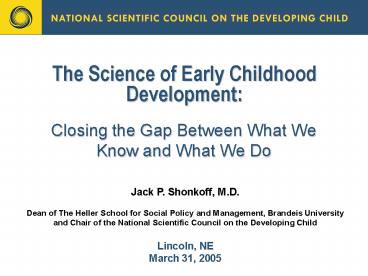The Science of Early Childhood Development: - PowerPoint PPT Presentation
1 / 19
Title:
The Science of Early Childhood Development:
Description:
Dean of The Heller School for Social Policy and Management, Brandeis University. and Chair of the National Scientific Council on the Developing Child. Lincoln, NE ... – PowerPoint PPT presentation
Number of Views:68
Avg rating:3.0/5.0
Title: The Science of Early Childhood Development:
1
The Science of Early Childhood Development
- Closing the Gap Between What We Know and What We
Do
Jack P. Shonkoff, M.D. Dean of The Heller School
for Social Policy and Management, Brandeis
University and Chair of the National Scientific
Council on the Developing Child Lincoln,
NE March 31, 2005
2
- Each of us is the product of a continuous
interaction between the influence of our personal
life experiences and our unique genetic
endowment.
3
- Nurturing, responsive, and individualized
relationships in the early years build healthy
brain architecture that provides a strong
foundation for all future growth and development.
4
- Excessive and repeated stress causes the release
of chemicals that disrupt the evolving
architecture of the brain by impairing its growth
and hindering the formation of healthy neural
circuits.
5
Normal Brain Architecture is Established Through
the Development of Highly Integrated Neural
Circuits that are Built in a Specific Sequence,
Within the Time Constraints of Sensitive Periods
- The good news
- The window of opportunity for skill development
generally remains open for many years
- The sobering news
- Positive adaptation in the face of impaired
brain circuits is more difficult and costly than
getting it right the first time
6
- Early childhood interventions can have
substantial positive impacts that result in a
significant return on investment, but those that
work are rarely simple, inexpensive, or easy to
implement.
7
Data to Think About
- The Abecedarian Project generated a total
benefit-cost ratio of 41 at age 21 - The Chicago Child-Parent Centers produced
benefit-cost ratios of 71 total and 41 public
at age 22 - Perry Preschool Project follow-up data at age 40
indicate a total benefit-cost ratio of 171 (41
for participants and 131 for the public)
8
More Data to Think About
- Rolnick Grunewald (2004) calculated internal
rates of return for the Perry Preschool Project
and estimated a total annual return of 18 (1
participant gain and 17 public benefit) - Participant benefits are derived largely from
higher earned income - Public benefits include higher tax revenues and
lower costs for special education, welfare
support, and incarceration
9
Still More to Ponder
- In a recent survey of 119 preschool teachers, 39
reported expelling at least one child from their
program in the preceding 12 months. (Gilliam,
2004) - In a recent study of 104 children under age 3
with newly opened child protection cases, 54 had
delays that met eligibility criteria for early
intervention services (MECLI, 2004)
10
Observations of a Nobel Laureate Economist
- Enriched pre-kindergarten programs available to
disadvantaged children on a voluntary basis,
coupled with home visitation programsare likely
to generate substantial savings to society and to
promote higher economic growth by improving the
skills of the workforce. (Heckman Masterov,
2004) - Our analysis challenges the conventional point
of view that equates skill with intelligence and
draws on a body of research that demonstrates the
importance of both cognitive and non-cognitive
skills in determining socioeconomic success.
(Carneiro Heckman, 2004)
11
Three Take Home Messages for Policy Makers
12
- If we really want to enhance children's readiness
to succeed in school, then we must pay as much
attention to their emotional health and social
competence as we do to their cognitive abilities
and academic skills.
13
- If we really want a knowledge-based system of
early care and education, then we cannot tolerate
low skill levels and high turnover rates in
preschool teachers and caregivers.
14
A Proposed Two-Pronged Strategy For a
Science-Based Early Childhood Agenda
- Universal access to Pre-K for 3 and 4 year olds,
with proactive enrollment of children from low
income families, as an investment in reducing
inequalities in pre-school opportunities - Targeted intervention in the first 3 years for
highly vulnerable children who experience toxic
stress that jeopardizes both early brain
development and lifelong health, learning, and
behavior
15
Three Core Challenges for Our Society
16
- Closing the Gap Between What We Know and What We
Do - Need to address the paradox of a rich and
growing science base yet persistent resistance to
significant investment in the healthy development
of young children
17
- Changing the Framework For Public Discussion
- Need for new strategies to build public will
that transcend political partisanship and
recognize the complementary responsibilities of
family, community, workplace, and government to
promote child health and development
18
Building New Leadership
- Need for bipartisan cooperation among leaders in
both the public and private sectors to address
inequalities in opportunity, starting in the
earliest years of life, as both a serious moral
problem and a significant social and economic
threat to our nations future
19
www.developingchild.net































